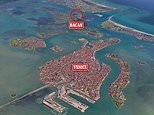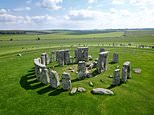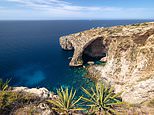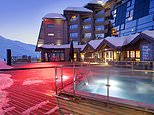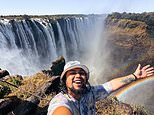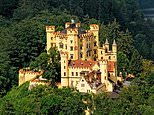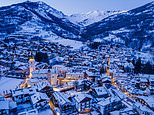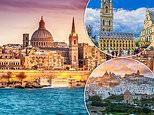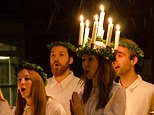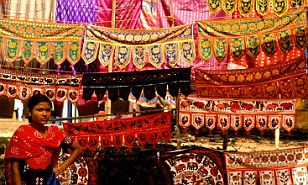EXCLUSIVEBoris Johnson visits Easter Island - 'the place to be to avoid nuclear fall-out from WWIII'. While he's there the former PM sets about solving the mystery of its enigmatic statues...
- Easter Island is 2,500 miles from mainland Chile, 7,000 miles from New Zealand
- Boris Johnson visits with his wife, Carrie, describing it as 'enchanting'
- The former PM investigates why the population disappeared
- READ MORE: I moved to Greece - here's why you should follow in my footsteps
Wow, I think, as we cycle the deserted road. If you are really worried about World War Three – and you want to avoid the nuclear fall-out – then this is the place to be.
You never saw a landscape so enchanting or so lonely. It’s barely 7pm and there’s plenty of light left in the day, but not a single car passes us. For mile after mile we see no human habitation, just cows grazing the upland pastures. The wind is mild, grass lush, sky grey.
This is Chile’s Easter Island – but it could be the west coast of Ireland, except for these strange green conical volcanoes, hundreds of metres high. On our right is the south coast, with its turquoise Pacific rollers crashing into the black volcanic rock of the shore.
If the islands of Polynesia were a solar system, this would be Pluto. If they were the dots on the old Central Line tube map, then this would be Ongar. My wife, Carrie, and I have come to the world’s last bus stop, the back of beyond, a tiny pimple on the rear end of nowhere.
We are about 2,500 miles from mainland Chile, and about 7,000 miles from New Zealand. It is the loneliest place on the planet, except that of course we are not alone.
Out of the corner of my eye, I detect a human shape; and then another, and another. Here they are at last, the peculiar people I have been waiting all my life to encounter face to face.
We dismount, open a rickety wooden gate, and walk through cowpats and lupins towards the shore, until we are only feet away. You aren’t supposed to go too close to the gods of Easter Island, not these days. There are signs on the cropped grass.
But we feel drawn as if by some instinct, and, without exactly disobeying the signs, we walk down towards the coast, keeping the huge figures on our right – until we find ourselves in a spooky place, somehow between the statues and the sea.

Boris Johnson visits Easter Island (above) with his wife, Carrie. 'You never saw a landscape so enchanting or so lonely,' he says. 'If you are really worried about World War Three – and you want to avoid the nuclear fall-out – then this is the place to be'

Statue selfie: Boris and wife Carrie
There is a long stone ledge carved in the rock, about 6ft tall and 6ft wide, so close to the shore that you could feel the spray; and now the gigantic divinities are invisible above us as we walk behind the altar, for about 50ft, until we can go no further, and so we turn and come out among them – purely by mistake, I want you to know.
We have emerged into the holy precinct itself, and I cannot contain my curiosity. I reach out to touch one of the fallen statues – or moai – his colossal forehead buried in the turf, his very earlobe as tall as we are; and as I look down I see that we are actually standing on one of them. Beneath our feet, almost completely buried, is the shape of a human face.
There is an eye socket dwarfing Carrie’s foot; and another; and his nose, and – well – as you can imagine, we leap off this glaring god like a pair of scalded cats.
So I apologise to the people of Rapa Nui, or Easter Island, for accidentally trespassing on this sacred site; and yet I can’t help feeling that if it were a sin, it’s forgivable.
You couldn’t claim that the religion is practised today, or even understood. The cows wander freely among these altars. It wasn’t the Europeans who knocked these godheads down. It wasn’t we who humbled the humongous humanoids.
It was the people of Easter Island themselves. It was they who exalted the moai, and they who tore them down – and all my life I have wondered why.
My obsession was fired at the age of about ten when I read Aku Aku by Thor Heyerdahl, in which the great Norwegian explorer argued (unconvincingly, they say) that Easter Island had been settled from Peru. My researches continued at Oxford, where in my otherwise entirely dissipated first year of study the only lecture I attended was on Easter Island, even though it was completely irrelevant to my actual curriculum.
There in the Pitt Rivers museum I learned what has been for decades the dominant theory. It was an ecocide, the professor said, an environmental catastrophe. It is an idea that has been echoed in many books, including Jared Diamond’s Collapse.

Remote: Rano Kau volcano at the south-western tip of Easter Island

Boris reveals that he has long been obsessed with why the people of Easter Island tore their statues down
The gist of it is that over hundreds of years the islanders were so obsessed with their statue-building cult that they became ever more ambitious and competitive. So they needed more and more wooden scaffolding and more and more rollers to manoeuvre the 14-ton anthropomorphs into place.
So they cut down trees, and without the trees the soil was washed away – and lo! Humanity was punished for overdevelopment. The crops failed, the population dwindled to almost nothing, and the giant statues were felled by time and tsunamis.
For generations, that has been the moral of Easter Island – that human activity can trigger a sudden eco-disaster that endangers our very civilisation.
Yes, the fate of the Easter Islanders has been held up as a lesson for the whole of the human race, a finger-wagging warning about the dangers of anthropogenic climate change. The message of Easter island, on this reading, is that by damaging the environment, we can imperil the entire future of humanity.
Well, that may very well be true – as a general proposition. But as an explanation of what happened to the people of Easter Island, I now think it is probably total balls.
Over the best part of two days, we cycle a big chunk of the beautiful island – a triangle in which the hypotenuse is only 14 miles long. We swim at Anakena, with its golden-pink sand and water that is clear and blue, though not exactly tropical.
We look from a respectful distance at many of the other re-erected man-mountain monoliths. And after much conversation with the locals, especially with Ricky, the thoughtful guide at the Explora hotel, I can see why so many scholars now reject the ecocide theory.
Explora is a beautiful timbered structure looking out over the south coast, where the breakfasts are generous and they take the archaeology seriously. After spending more than ten years showing people round, and listening to the theories, Ricky has formed a view.

Explora hotel 'is a beautiful timbered structure looking out over the south coast, where the breakfasts are generous and they take the archaeology seriously'

Easter Island is one of the most remote islands in the world. Its nearest inhabited neighbour is Pitcairn Island, more than 1,200 miles away
So, here is what I reckon really happened. It looks as though the Polynesians first got to this island about 800 years ago. You can imagine that they were aware just how far they had come. So they quarried these statues from the volcanic tuff, to honour the genius of their seafaring ancestors, and they rocked them into place; not on rollers, but rocking them upright as you rock a wardrobe along a floor, pulling ropes and singing shanties.
And for centuries, since they were so far away from the rest of humanity, they blissfully indulged their cult.
They dressed the statues in feathers; they gave them white coral eyeballs; they chanted their praises and every year they added more until there were about a thousand dotted around the island.
Things seemed to go well. Easter Island is temperate and fertile, and they had large numbers of chickens, which they kept in elaborate stone coops. The population rose and prospered, until there were many thousands living on the island – and it does not seem, from the human remains, that they were especially violent towards one another.
So what went wrong? Sometime in the 1600s the rate of statue production goes into a sharp decline. It was a period – as Ricky reminds – that coincided with the mini ice age.
Could it have been that after centuries of practising the same religion – thanking and propitiating their ancestors – they started to worry that it just wasn’t working? They were carving bigger and bigger moai, some of them heavier than a Boeing 737; and yet the weather was getting colder and colder.
Then, in 1722, something truly shattering happened. A Dutchman called Jacob Roggeveen made landfall – the first European to discover the place. As they looked at that enormous European ship, they realised a dreadful truth: that their seafaring ancestors – the gods of these statues – were not so special after all.
There followed a catastrophic period of self-doubt, and recrimination.
As with mediaeval Christianity, as with Islam, they decided that somehow their sufferings were caused by their very reliance on graven images. In a fit of puritan iconoclasm they – or some of them – decided to tear down these masterpieces.
The happy island was engulfed by a struggle between those who still clung to the old faith, and those who believed that the old idols had manifestly failed, and were interrupting the relationship between man and god, and that it was time for a new and purer religion.
That’s my guess, and I bet I’m right. It wasn’t ecocide. It was religious strife, and civil war, and a collapse of confidence and leadership. Yup, folks, the one and only lecture I went to in the whole of a drunken and crapulous taxpayer-funded year at university turns out to have been completely wrong.
It wasn’t poverty; it wasn’t disease; it wasn’t crop failure; it wasn’t famine. It certainly wasn’t some environmental problem to do with soil erosion that caused the collapse of the Easter Island culture.
It was politics that destroyed this amazing civilisation, as it almost always is. And that is the real lesson for the human race.
- Boris Johnson's memoir, Unleashed, is out now (£30). Visit harpercollins.co.uk to order.





